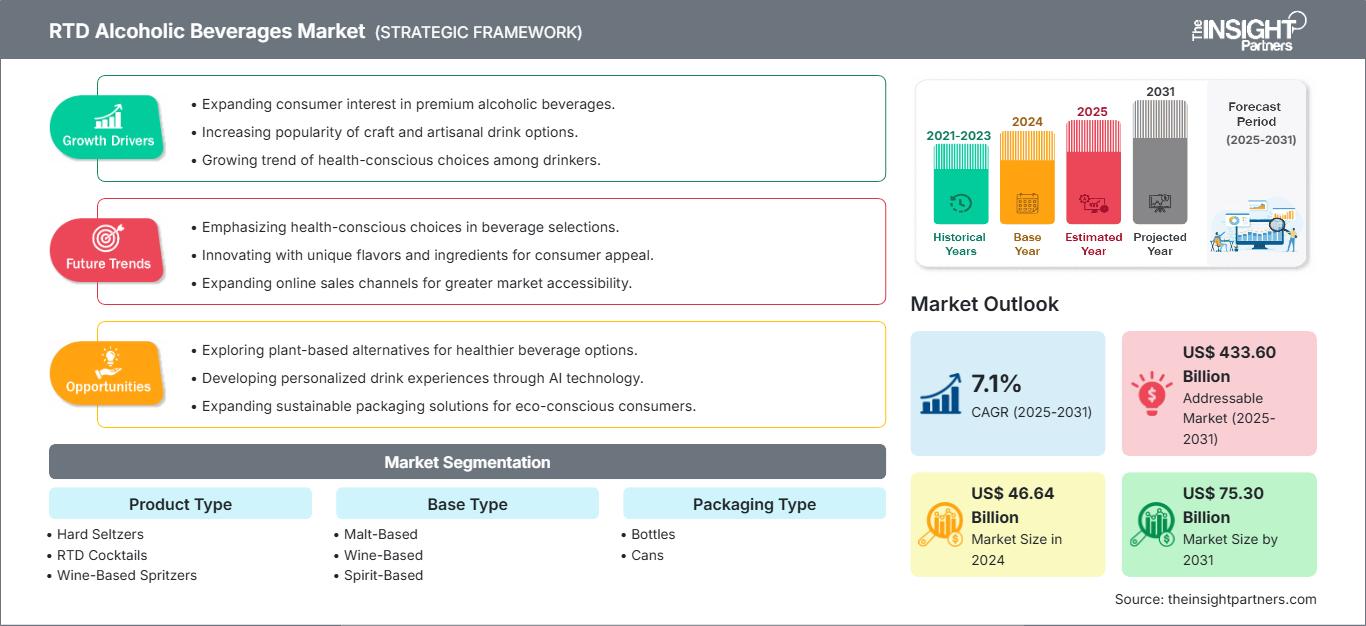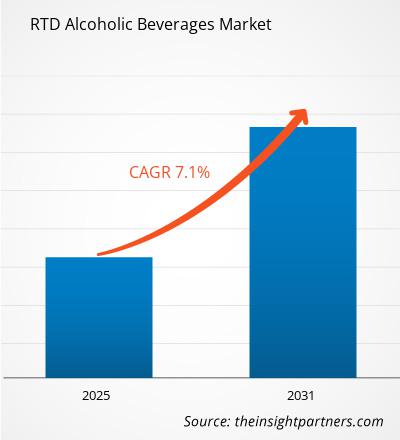Der Markt für alkoholische Fertiggetränke soll von 46,64 Milliarden US-Dollar im Jahr 2024 auf 75,30 Milliarden US-Dollar im Jahr 2031 anwachsen. Für den Zeitraum 2025–2031 wird ein CAGR von 7,1 % erwartet. Die steigende Nachfrage nach alkoholischen Getränken mit niedrigem/reduziertem Zuckergehalt dürfte im Prognosezeitraum einen neuen Trend auf dem Markt für alkoholische Fertiggetränke auslösen.
Marktanalyse für alkoholische Fertiggetränke
Der Markt für alkoholische Fertiggetränke wird durch die zunehmende Premiumisierung und Innovation bei alkoholischen Fertiggetränken angetrieben. Wichtige Marktteilnehmer, die sich auf die Einführung neuer innovativer Geschmacksrichtungen konzentrieren, tragen zum Marktwachstum bei. Mit zunehmender Urbanisierung und einem geschäftigen Lebensstil steigt die Nachfrage nach praktischen, konsumfertigen Getränken, die gesundheitsbewussten Entscheidungen gerecht werden. Die Beliebtheit alkoholischer Getränke mit niedrigem bzw. reduziertem Zuckergehalt hat stark zugenommen, da sie im Vergleich zu herkömmlichen alkoholischen Getränken als leichter und gesünder wahrgenommen werden. Darüber hinaus locken Innovationen bei Geschmacksrichtungen und Produktangeboten kontinuierlich neue Verbraucher an, insbesondere unter jüngeren Bevölkerungsgruppen.
Marktübersicht für trinkfertige alkoholische Getränke
Ready-to-drink (RTD) alkoholische Getränke sind vorgemischte Getränke, die zum sofortigen Verzehr bereit sind. Es gibt verschiedene Optionen, darunter Hard Seltzer, Cocktails in Dosen und Weinschorlen, und sie sind normalerweise in Einzelportionspackungen erhältlich. Der Markt für trinkfertige alkoholische Getränke hat aufgrund veränderter Verbraucherpräferenzen und Lifestyle-Trends ein erhebliches Wachstum erlebt. Mit der zunehmenden Urbanisierung und vollen Terminkalendern suchen Verbraucher nach praktischen Optionen, die ihren gesundheitsbewussten Entscheidungen entsprechen. In diesem Zusammenhang haben Hard Seltzer aufgrund ihres leichteren und gesünderen Images im Vergleich zu herkömmlichen alkoholischen Getränken an Beliebtheit gewonnen. Die Attraktivität von Hard Seltzer wird durch kontinuierliche Innovationen bei Geschmacksrichtungen und Produktvarianten gesteigert und spricht eine vielfältige Verbraucherbasis an, insbesondere jüngere Zielgruppen. Da Marken ihr Angebot erweitern und neue Märkte erschließen, ist das Segment der trinkfertigen alkoholischen Getränke auf anhaltendes Wachstum eingestellt und bedient die Nachfrage nach erfrischenden und praktischen Getränken, die zum modernen Lebensstil passen. Insgesamt entwickelt sich dieser Markt rasant und spiegelt umfassende Veränderungen im Verbraucherverhalten und den Vorlieben in der Getränkeindustrie wider.
Passen Sie diesen Bericht Ihren Anforderungen an
Sie erhalten kostenlos Anpassungen an jedem Bericht, einschließlich Teilen dieses Berichts oder einer Analyse auf Länderebene, eines Excel-Datenpakets sowie tolle Angebote und Rabatte für Start-ups und Universitäten.
Markt für alkoholische Getränke mit RTD-Technologie: Strategische Einblicke

-
Holen Sie sich die wichtigsten Markttrends aus diesem Bericht.Dieses KOSTENLOSE Beispiel umfasst Datenanalysen, die von Markttrends bis hin zu Schätzungen und Prognosen reichen.
Markttreiber und -chancen für trinkfertige alkoholische Getränke
Marketing- und Branding-Strategien wichtiger Marktteilnehmer
Hersteller von trinkfertigen alkoholischen Getränken und Hard Seltzer konzentrieren sich auf strategische Entwicklungsinitiativen wie Marketing, Branding und die Expansion ihrer Geschäfte, um Kunden anzulocken und ihre Marktposition zu stärken. Marktteilnehmer nutzen gezielte Marketingstrategien mit gesundheitsbewussten Botschaften, Influencer-Partnerschaften, innovativen Verpackungen und digitaler Werbung, um die sich wandelnden Verbraucherpräferenzen zu erfassen. Das Branding dieser Getränke als gesunde Alternative zu herkömmlichem Bier und zuckerhaltigen Cocktails fördert ihre Akzeptanz. White Claw beispielsweise setzte sich für die Kampagne „Better for you“ ein und betonte kalorien- und zuckerarme Rezepturen, die bei Millennials und der Generation Z Anklang finden, die Wert auf ihr Wohlbefinden legen, ohne auf Alkohol zu verzichten. Eine weitere Strategie ist intensives Social-Media-Marketing, bei dem Marken virale Trends, Memes und die Zusammenarbeit mit Influencern nutzen, um das Engagement zu fördern. Social Media hat den Popularitätsanstieg von White Claw maßgeblich durch die Kampagne „White Claw Summer“ vorangetrieben, in deren Rahmen Verbraucher und Influencer ihre Erfahrungen mit dem Produkt teilten.
Wachstum im On-Trade- und E-Commerce-Kanal
Die schnelle Expansion der On-Trade-Kanäle (d. h. Bars, Restaurants und Hotels) und des E-Commerce wird dem Markt im Prognosezeitraum voraussichtlich erhebliche Wachstumschancen bieten. Der Wandel der Verbraucherpräferenzen hin zu Bequemlichkeit, Premium-Erlebnissen und digitalem Shopping hat die Nachfrage nach trinkfertigen alkoholischen Getränken über diese Kanäle angeheizt. Mit dem Fortschritt der globalen Gastronomie nehmen Bars, Restaurants und Unterhaltungsstätten trinkfertige alkoholische Getränke in ihre Speisekarten auf und erkennen damit die Attraktivität für Verbraucher, die nach hochwertigen Alternativen zu traditionellen Cocktails suchen. Einer der Hauptfaktoren, die den On-Trade-Kanal ankurbeln, ist die zunehmende Akzeptanz von RTD-Cocktails in Bars und Restaurants, wo die Verbraucher Premiumgetränke in Verbindung mit Mixologie-basierten Cocktails suchen. Laut dem 2023 veröffentlichten Bericht der National Restaurant Association sagen 84 % der über 21-Jährigen, die Wein, Bier oder Cocktails trinken, dass Restaurants ein großartiger Ort sind, um neue alkoholische Getränke zu entdecken. Bier- (70 %), Wein- (69 %) und Cocktailkonsumenten (67 %) wählen ein Restaurant eher aufgrund seiner Alkoholauswahl aus. 34 % der über 21-Jährigen sagen, dass sie im Restaurant einen Cocktail zu einer Mahlzeit trinken würden, und 21 % sagen, dass sie zu Hause einen Cocktail zu einer Mahlzeit trinken würden. Millennials (44 %) bestellen in Restaurants am häufigsten einen Cocktail oder Mixdrink, gefolgt von der Generation X (35 %).
Segmentierungsanalyse des Marktberichts für alkoholische Getränke mit alkoholfreiem Getränk
Schlüsselsegmente, die zur Ableitung der Marktanalyse für alkoholische Getränke mit alkoholfreiem Getränk beigetragen haben, sind Produkttyp, Basistyp, Verpackungstyp, Kategorie und Vertriebskanal.
- Basierend auf dem Produkttyp ist der Markt in Hard Seltzer, alkoholfreie Cocktails, weinbasierte Schorlen und Sonstiges segmentiert. Das Segment der alkoholfreien Cocktails wird im Prognosezeitraum voraussichtlich die höchste CAGR verzeichnen.
- In Bezug auf den Basistyp ist der Markt in malzbasierte, weinbasierte und spirituosenbasierte Getränke kategorisiert. Das spirituosenbasierte Segment wird im Prognosezeitraum voraussichtlich die höchste CAGR verzeichnen.
- Nach Verpackungstyp ist der Markt in Flaschen, Dosen und Sonstiges segmentiert. Das Dosensegment hatte 2024 den größten Marktanteil.
- Nach Kategorien ist der Markt in zuckerarm/zuckerfrei und normal unterteilt. Es wird erwartet, dass das zuckerarme/zuckerfreie Segment den Markt im Prognosezeitraum dominieren wird.
- Auf Grundlage der Vertriebskanäle ist der Markt in On-Trade und Off-Trade unterteilt. Es wird erwartet, dass das On-Trade-Segment im Prognosezeitraum die höchste durchschnittliche jährliche Wachstumsrate verzeichnet.
Marktanteilsanalyse für alkoholische Getränke mit alkoholischer Gärung nach Geografie
Der geografische Umfang des Marktberichts für alkoholische Getränke mit alkoholischer Gärung ist in fünf Regionen unterteilt: Nordamerika, Asien-Pazifik, Europa, Naher Osten und Afrika sowie Süd- und Mittelamerika. Der Markt für trinkfertige alkoholische Getränke im asiatisch-pazifischen Raum wird im Prognosezeitraum voraussichtlich deutlich wachsen.
Im asiatisch-pazifischen Raum steigt die Nachfrage nach trinkfertigen alkoholischen Getränken und Hard Seltzer aufgrund veränderter Verbraucherpräferenzen, insbesondere bei jungen und städtischen Menschen. Diese Verbraucher legen Wert auf Komfort, Mobilität und Abwechslung, was trinkfertige Getränke zu einer attraktiven Wahl macht, da sie eine unkomplizierte, vorgemischte Option für gesellige Zusammenkünfte und den gelegentlichen Konsum bieten. Das steigende Gesundheitsbewusstsein und die steigenden verfügbaren Einkommen treiben die Beliebtheit von alkohol- und zuckerarmen Alternativen voran. Die wachsende Social-Media- und Influencer-Kultur hat ebenfalls zur Popularität dieser Produkte beigetragen und entspricht dem Trend zu zwanglosen und inklusiven Trinkerlebnissen.
trinkfertige alkoholische Getränke
Regionale Einblicke in den Markt für alkoholische Getränke mit RTD-TechnologieDie Analysten von The Insight Partners haben die regionalen Trends und Faktoren, die den Markt für alkoholische Getränke im Prognosezeitraum beeinflussen, ausführlich erläutert. In diesem Abschnitt werden auch die Marktsegmente und die geografische Verteilung von alkoholischen Getränken in Nordamerika, Europa, im asiatisch-pazifischen Raum, im Nahen Osten und Afrika sowie in Süd- und Mittelamerika erläutert.
Umfang des Marktberichts über alkoholische Getränke mit RTD-Technologie
| Berichtsattribut | Einzelheiten |
|---|---|
| Marktgröße in 2024 | US$ 46.64 Billion |
| Marktgröße nach 2031 | US$ 75.30 Billion |
| Globale CAGR (2025 - 2031) | 7.1% |
| Historische Daten | 2021-2023 |
| Prognosezeitraum | 2025-2031 |
| Abgedeckte Segmente |
By Produkttyp
|
| Abgedeckte Regionen und Länder |
Nordamerika
|
| Marktführer und wichtige Unternehmensprofile |
|
Dichte der Marktteilnehmer für alkoholische Getränke mit RTD-Geschmack: Auswirkungen auf die Geschäftsdynamik verstehen
Der Markt für alkoholische Getränke mit trinkfertiger Zubereitung wächst rasant. Die steigende Nachfrage der Endverbraucher ist auf Faktoren wie veränderte Verbraucherpräferenzen, technologische Fortschritte und ein stärkeres Bewusstsein für die Produktvorteile zurückzuführen. Mit der steigenden Nachfrage erweitern Unternehmen ihr Angebot, entwickeln Innovationen, um den Bedürfnissen der Verbraucher gerecht zu werden, und nutzen neue Trends, was das Marktwachstum weiter ankurbelt.

- Holen Sie sich die Markt für alkoholische Getränke mit RTD-Technologie Übersicht der wichtigsten Akteure
Marktneuigkeiten und aktuelle Entwicklungen für alkoholische Getränke mit trinkfertiger Zubereitung
Der Markt für alkoholische Getränke mit trinkfertiger Zubereitung wird durch die Erhebung qualitativer und quantitativer Daten aus Primär- und Sekundärforschung bewertet, die wichtige Unternehmensveröffentlichungen, Verbandsdaten und Datenbanken umfasst. Einige der wichtigsten Entwicklungen auf dem Markt für alkoholische Getränke mit trinkfertiger Zubereitung sind wie folgt:
- ATRÓN Tequila hat den Start der Kampagne „Tequila ohne Zusatzstoffe“ angekündigt und betont damit seine Tradition ohne Zusatzstoffe und den handwerklichen Herstellungsprozess. (Quelle: ATRÓN Tequila, Unternehmenswebsite, Februar 2025)
- The Coca-Cola Company und Bacardi Limited haben eine Vereinbarung zur Einführung von BACARDÍ Rum und Coca-Cola als trinkfertigen (RTD) Fertigcocktail bekannt gegeben. BACARDÍ Gemischt mit Coca-Cola RTD ist in mehreren Märkten weltweit erhältlich, wobei die Markteinführung in ausgewählten europäischen Märkten und Mexiko im Jahr 2025 geplant ist. (Quelle: The Coca-Cola Company, Unternehmenswebsite, September 2024)
Bericht zum Markt für alkoholische RTD-Getränke: Abdeckung und Ergebnisse
Der Bericht „Marktgröße und Prognose für alkoholische RTD-Getränke (2021–2031)“ bietet eine detaillierte Analyse des Marktes und deckt die folgenden Bereiche ab:
- Marktgröße und Prognose für alkoholische RTD-Getränke auf globaler, regionaler und Länderebene für alle wichtigen Marktsegmente, die im Rahmen abgedeckt sind
- Markttrends für alkoholische RTD-Getränke sowie Marktdynamik wie Treiber, Einschränkungen und wichtige Chancen
- Detaillierte Porter’s Five Forces-Analyse und SWOT-Analyse
- Marktanalyse für alkoholische RTD-Getränke mit wichtigen Markttrends, globalen und regionalen Rahmenbedingungen, wichtigen Akteuren, Vorschriften und aktuelle Marktentwicklungen
- Branchenlandschaft und Wettbewerbsanalyse mit Marktkonzentration, Heatmap-Analyse, prominenten Akteuren und aktuellen Entwicklungen für den Markt für trinkfertige alkoholische Getränke
- Detaillierte Unternehmensprofile
- Historische Analyse (2 Jahre), Basisjahr, Prognose (7 Jahre) mit CAGR
- PEST- und SWOT-Analyse
- Marktgröße Wert/Volumen – Global, Regional, Land
- Branchen- und Wettbewerbslandschaft
- Excel-Datensatz
Aktuelle Berichte
Verwandte Berichte
Erfahrungsberichte
Grund zum Kauf
- Fundierte Entscheidungsfindung
- Marktdynamik verstehen
- Wettbewerbsanalyse
- Kundeneinblicke
- Marktprognosen
- Risikominimierung
- Strategische Planung
- Investitionsbegründung
- Identifizierung neuer Märkte
- Verbesserung von Marketingstrategien
- Steigerung der Betriebseffizienz
- Anpassung an regulatorische Trends






















 Kostenlose Probe anfordern für - Markt für alkoholische Getränke mit RTD-Technologie
Kostenlose Probe anfordern für - Markt für alkoholische Getränke mit RTD-Technologie